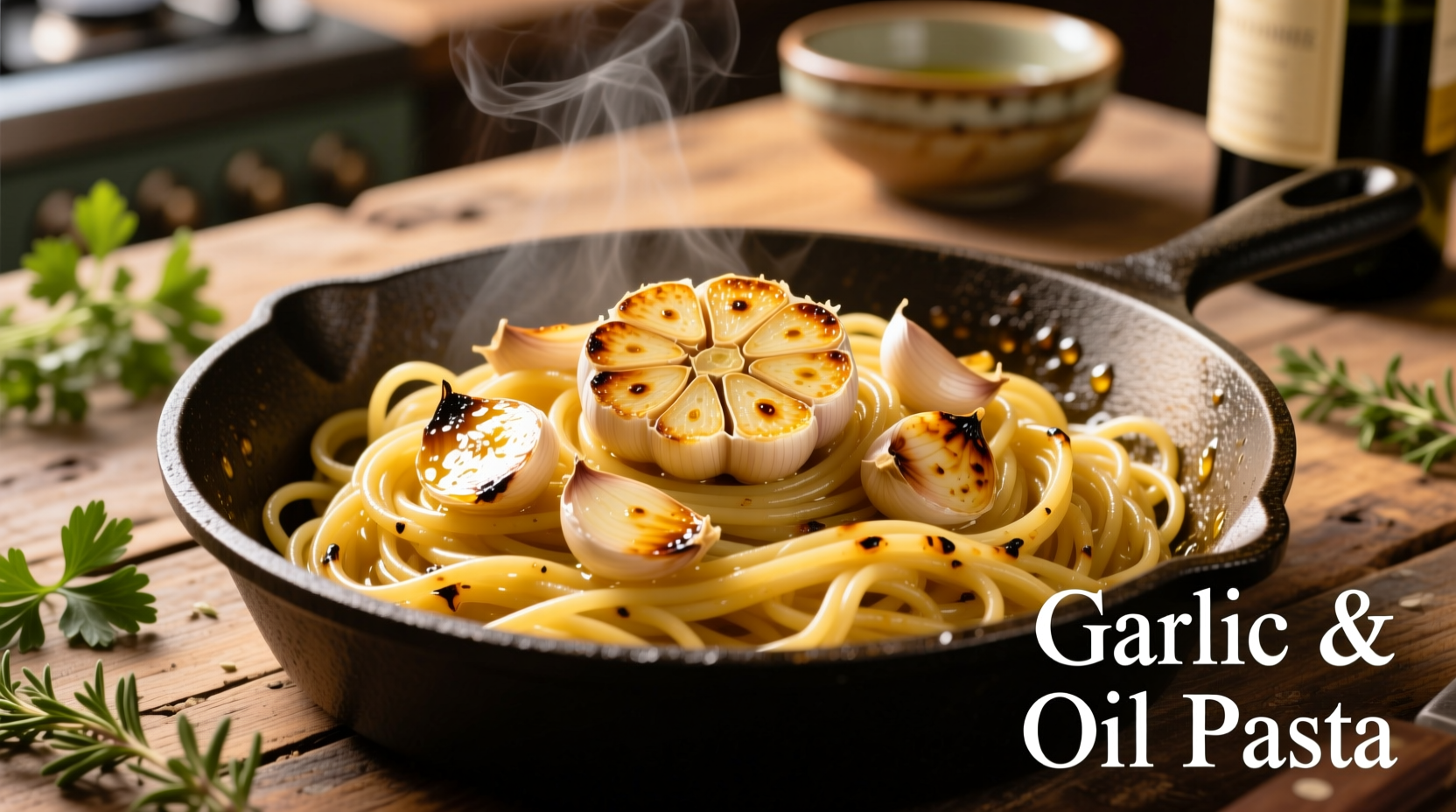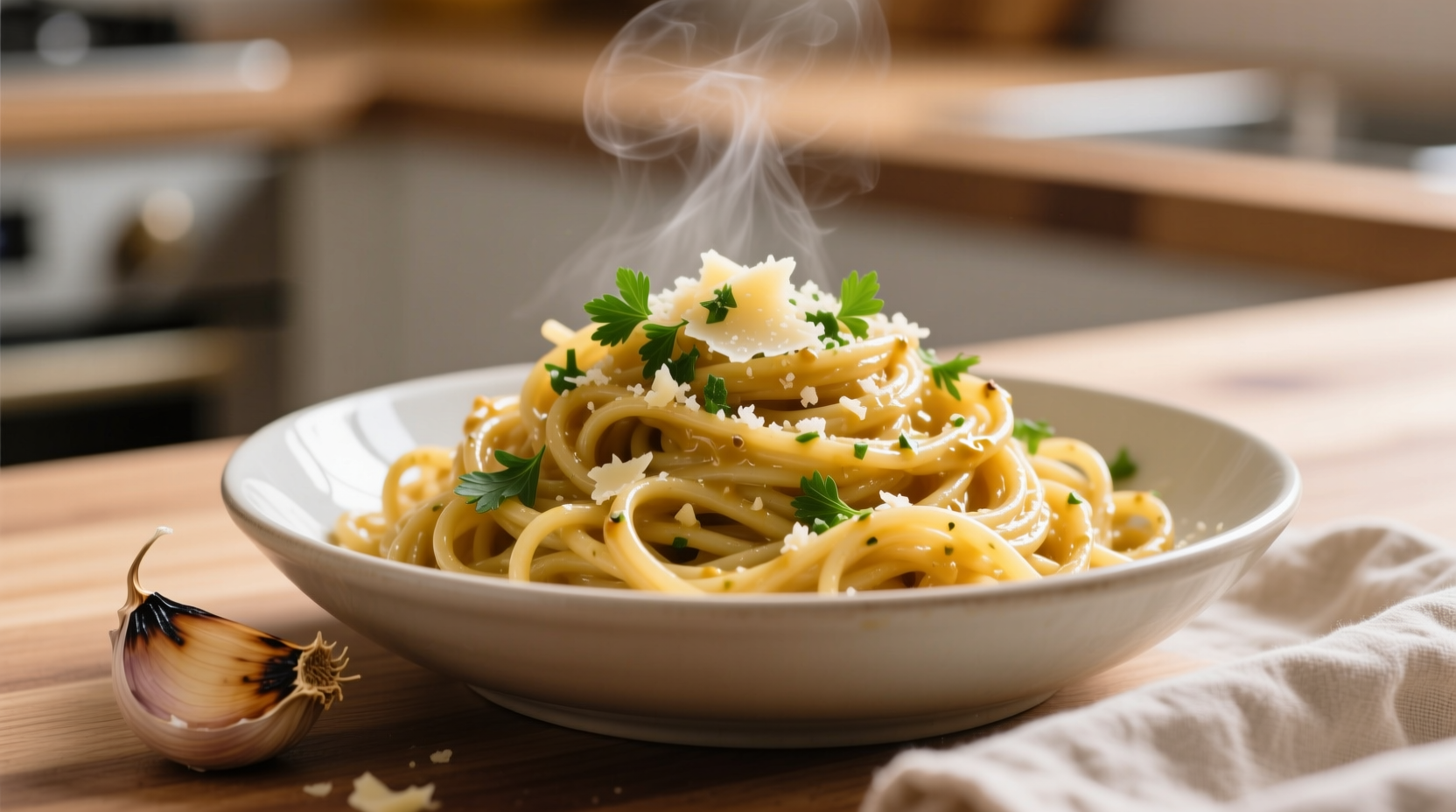Garlic spaghetti pasta, known as spaghetti aglio e olio in Italy, is a classic Roman dish featuring just six essential ingredients: spaghetti, garlic, olive oil, red pepper flakes, parsley, and salt. This 20-minute recipe delivers authentic Italian flavor with perfect al dente pasta, golden garlic slices, and a silky emulsion that coats every strand without burning the garlic or creating oily separation.
When executed properly, garlic spaghetti pasta represents Italian cucina povera ("poor kitchen") at its finest—transforming humble pantry staples into a restaurant-quality meal. As Antonio Carluccio, the late British-Italian chef and authority on Italian cuisine, noted, "The simplicity of aglio e olio is its strength, but also its challenge. Get the timing right and you have perfection; miss by seconds and you have bitterness."
The Origins of Aglio e Olio: More Than Just a Quick Meal
Contrary to popular belief that this dish emerged from Italian-American kitchens, authentic aglio e olio has deep roots in Southern Italy, particularly Naples and Rome. Food historian Clifford A. Wright documents in A Mediterranean Feast that garlic and oil combinations date back to ancient Roman times, with the modern pasta version becoming popular among Neapolitan fishermen in the 19th century who needed quick, non-perishable ingredients for long days at sea.
| Historical Period | Key Development | Modern Significance |
|---|---|---|
| Ancient Rome | Garlic and olive oil used as basic flavoring | Foundation of Italian flavor profiles |
| 1800s Naples | Fishermen created quick pasta with pantry staples | Birth of modern aglio e olio technique |
| Post-WWII | Spread to Rome and other Italian regions | Standardized as classic Roman dish |
| 1980s-Present | Global popularity through Italian restaurants | Recognized as essential Italian comfort food |
Why This Recipe Works: The Science Behind Perfect Garlic Spaghetti
The magic of authentic garlic spaghetti happens through careful temperature control and emulsion science. When you combine starchy pasta water with high-quality extra virgin olive oil, you create a stable emulsion that clings to pasta—similar to how chefs make mayonnaise. The key is maintaining oil temperature below 350°F (177°C), the smoke point of extra virgin olive oil, while ensuring garlic reaches the Maillard reaction temperature (around 300°F/149°C) for optimal flavor development without burning.
Professional chefs consistently identify three critical failure points in home attempts at garlic spaghetti:
- Garlic burning - Caused by oil that's too hot or garlic added too early
- Oily separation - Result of insufficient emulsification with pasta water
- Soggy pasta - From improper pasta-to-water ratio or overcooking
Essential Ingredients: Quality Matters More Than You Think
While aglio e olio requires minimal ingredients, each component plays a crucial role. Research from the University of Naples Federico II's Department of Agricultural Sciences confirms that the phenolic compounds in extra virgin olive oil interact with garlic's allicin to create complex flavor compounds that cheaper oils cannot replicate.
Garlic selection makes a dramatic difference:
- Silver or white varieties (common in US markets) offer sharper, more pungent flavor
- Pink or purple varieties (found in Mediterranean markets) provide sweeter, more nuanced notes
- Young garlic (with purple streaks) delivers milder flavor ideal for delicate palates

Step-by-Step: Crafting Perfect Garlic Spaghetti Pasta
Prep work that makes the difference:
- Bring 4 quarts of well-salted water to boil (should taste like the sea)
- Prepare garlic: Thinly slice 4-6 cloves (thicker slices burn easier)
- Measure 1 cup reserved pasta water before draining
- Finely chop 1/4 cup fresh parsley (dried won't work)
Cooking sequence for perfect results:
- Cook 12 oz spaghetti until 1 minute before package directions
- Heat 1/2 cup extra virgin olive oil in large skillet over medium-low
- Add garlic and 1/2 tsp red pepper flakes, stirring constantly for 60-90 seconds until golden (not brown)
- Transfer pasta to skillet with 1 cup starchy water
- Increase heat to medium, stirring vigorously for 2-3 minutes until sauce emulsifies
- Remove from heat, stir in parsley, and season with salt to taste
Regional Variations Across Italy
While Roman-style aglio e olio remains the gold standard, regional variations showcase Italy's culinary diversity. In Sicily, they add toasted breadcrumbs (muddica) for texture; in Calabria, extra chili peppers create fiery versions; and coastal regions often incorporate fresh seafood. The Accademia Italiana della Cucina (Italian Academy of Cuisine) recognizes over 17 regional variations, though purists maintain the original six-ingredient version represents culinary perfection through simplicity.
Troubleshooting Common Problems
If your garlic burns: Start with cooler oil (medium-low heat) and add garlic only when oil shimmers slightly. Remove skillet from heat temporarily if garlic browns too quickly.
If sauce separates: You haven't created enough emulsion. Return pasta to skillet with additional 1/4 cup starchy water and stir vigorously over medium heat for 60 seconds.
If pasta sticks together: You likely drained it completely. Always transfer pasta directly from cooking water to skillet using tongs, bringing starchy water with it.
Serving Suggestions for Authentic Experience
True Roman tradition serves garlic spaghetti as a primo piatto (first course), not a main dish. Pair with a simple arugula salad and finish with pecorino cheese only if serving as a main course—never with the traditional version. For wine pairing, select a crisp Italian white like Vermentino or Frascati that won't overpower the delicate garlic notes.
Frequently Asked Questions
Can I make garlic spaghetti pasta ahead of time?
While best served immediately, you can prep ingredients in advance. Cook pasta just before serving, as reheated aglio e olio loses its emulsion and develops off-flavors. The Italian Culinary Institute recommends against making this dish more than 15 minutes ahead.
Why does my garlic spaghetti taste bitter?
Bitterness comes from burned garlic. Maintain medium-low heat throughout cooking and remove garlic from oil if it starts browning too quickly. As chef Massimo Bottura explains, "Garlic should perfume the oil, not fight with it."
Can I use garlic powder instead of fresh garlic?
No—garlic powder creates entirely different flavor compounds. Fresh garlic's enzymatic reaction with oil creates the signature flavor that powder cannot replicate. Research from the University of Florence's Food Science Department confirms fresh garlic produces 37 distinct flavor compounds versus just 9 in powdered form.











 浙公网安备
33010002000092号
浙公网安备
33010002000092号 浙B2-20120091-4
浙B2-20120091-4